The Multi-Scale Model Method for U-Ribs Temperature-Induced Stress Analysis in Long-Span Cable-Stayed Bridges through Monitoring Data
Abstract
:1. Introduction
2. STB Monitoring Data and Statistical Analysis
2.1. STB and Its SHM System
2.2. Monitoring Data and Statistical Analysis of the Temperature and Structure Response
3. Analysis of Temperature-Induced Stress through Multi-Scale Modelling
3.1. STB Multi-Scale Modelling Using the Substructure Method
3.2. Thermal Field Analysis
3.3. Temperature-Induced Structural Responses
4. Conclusions
- (1)
- The temperature-induced stress of U-ribs on the STB was analyzed based on monitoring data and the multi-scale FE method. This method can be applied to other long-span bridges to address the issue of low computational efficiency in analyzing U-ribs in the global fine FE model.
- (2)
- Analysis of monitoring data indicates that the long-span steel box bridge with the tuyere components exhibits a vertical temperature gradient rather than a transverse temperature gradient. The correlation between temperature-induced displacement and temperature demonstrates a linear relationship once the time delay effect is considered. The temperature-induced strain of the top plates and bottom plates is influenced by the temperature between them. The temperature-induced strain of U-ribs is influenced by the temperature of the decks and U-ribs. Furthermore, the seasonal temperature and longitudinal strain over time within a year exhibit a sinusoidal relationship.
- (3)
- A multi-scale FE model, which can effectively reduce the calculation time based on the substructure method, has been established to analyze the temperature-induced stress of U-ribs on long-span bridges. The accuracy of the multi-scale FE model results for the temperature-induced stress of U-ribs has been confirmed through monitoring data.
- (4)
- By evaluating the temperature-induced strain during the highest and lowest temperatures of one day on the multi-scale FE model, it indicates that the deflection of the girder, a key index for bridge design and SHM assessment, exhibits dynamic changes in response to temperature loads. The temperature-induced strain of the top and bottom plates displays a maximum variation range of approximately 100 .
5. Recommendation
Author Contributions
Funding
Institutional Review Board Statement
Informed Consent Statement
Data Availability Statement
Conflicts of Interest
References
- Zhao, R.; Zheng, K.; Wei, X.; Jia, H.; Liao, H.; Li, X.; Wei, K.; Zhan, Y.; Zhang, Q.; Xiao, L.; et al. State-of-the-art and annual progress of bridge engineering in 2020. Adv. Bridge Eng. 2021, 2, 1–105. [Google Scholar]
- Zeng, Y.; Qiu, Z.; Yang, C.C.; Haozheng, S.; Xiang, Z.F.; Zhou, J.T. Fatigue experimental study on full-scale large sectional model of orthotropic steel deck of urban rail bridge. Adv. Mech. Eng. 2023, 15, 16878132231155271. [Google Scholar] [CrossRef]
- Guo, T.; Li, A.Q.; Wang, H. Influence of ambient temperature on the fatigue damage of welded bridge decks. Int. J. Fatigue 2008, 30, 1092–1102. [Google Scholar] [CrossRef]
- Liu, Y.; Zhang, H.P.; Liu, Y.M.; Deng, Y.; Jiang, N.; Lu, N.W. Fatigue reliability assessment for orthotropic steel deck details under traffic flow and temperature loading. Eng. Fail. Anal. 2017, 71, 179–194. [Google Scholar] [CrossRef]
- Xia, Q.; Xia, Y.; Wan, H.P.; Zhang, J.; Ren, W.X. Condition analysis of expansion joints of a long-span suspension bridge through metamodel-based model updating considering thermal effect. Struct. Control. Health Monit. 2020, 27, e2521. [Google Scholar] [CrossRef]
- Xiao, F.; Hulsey, J.L.; Balasubramanian, R. Fiber optic health monitoring and temperature behavior of bridge in cold region. Struct. Control. Health Monit. 2017, 24, e2020. [Google Scholar] [CrossRef]
- Wang, D.; Liu, Y.M.; Liu, Y. 3D temperature gradient effect on a steel–concrete composite deck in a suspension bridge with field monitoring data. Struct. Control. Health Monit. 2018, 25, e2179. [Google Scholar] [CrossRef]
- Yarnold, M.T.; Moon, F.L. Temperature-based structural health monitoring baseline for long-span bridges. Eng. Struct. 2015, 86, 157–167. [Google Scholar] [CrossRef]
- Ni, Y.Q.; Xia, H.W.; Wong, K.Y.; Ko, J.M. In-Service Condition Assessment of Bridge Deck Using Long-Term Monitoring Data of Strain Response. J. Bridge Eng. 2012, 17, 876–885. [Google Scholar] [CrossRef]
- Xia, Y.Y.; Shi, M.S.; Zhang, C.; Wang, C.X.; Sang, X.X.; Liu, R.; Zhao, P.; An, G.F.; Fang, H.Y. Analysis of flexural failure mechanism of ultraviolet cured-in-place-pipe materials for buried pipelines rehabilitation based on curing temperature monitoring. Eng. Fail. Anal. 2022, 142, 106763. [Google Scholar] [CrossRef]
- Zuk, W. Simplified Design Check of Thermal Stresses in Composite Highway Bridges; The National Academies of Sciences, Engineering, and Medicine: Washington, DC, USA, 1965; pp. 10–13. [Google Scholar]
- Peiris, A.; Sun, C.; Harik, I. Lessons learned from six different structural health monitoring systems on highway bridges. J. Low Freq. Noise V. A. 2018, 39, 616–630. [Google Scholar] [CrossRef]
- Ni, Y.Q.; Xia, Y.; Liao, W.Y.; Ko, J.M. Technology Innovation in Developing the Structural Health Monitoring System for Guangzhou New TV Tower. Struct. Control Health Monit. 2009, 16, 73–98. [Google Scholar] [CrossRef]
- Deng, Y.; Li, A.Q.; Chen, S.; Feng, D.M. Serviceability assessment for long-span suspension bridge based on deflection measurements. Struct. Control. Health Monit. 2018, 25, e2254. [Google Scholar] [CrossRef]
- Yuan, J.; Gan, Y.X.; Chen, J.; Tan, S.M.; Zhao, J.T. Experimental research on Consolidation creep characteristics and microstructure evolution of soft soil. Front. Mater. 2023, 10, 1137324. [Google Scholar] [CrossRef]
- Yang, Z.Y.; Yu, X.Y.; Dedman, S.; Rosso, M.; Zhu, J.M.; Yang, J.Q.; Xia, Y.X.; Tian, Y.C.; Zhang, G.P.; Wang, J.Z. UAV remote sensing applications in marine monitoring: Knowledge visualization and review. Sci. Total Envrion. 2022, 838, 155939. [Google Scholar] [CrossRef]
- Zhang, B.; Zhou, L.; Zhang, J. A methodology for obtaining spatiotemporal information of the vehicles on bridges based on computer vision. Comput. Aided Civ. Inf. 2018, 34, 471–487. [Google Scholar] [CrossRef]
- Zhao, W.; Guo, S.; Zhou, Y.; Zhang, J. A Quantum-Inspired Genetic Algorithm-Based Optimization Method for Mobile Impact Test Data Integration. Comput. Aided Civ. Inf. 2018, 33, 411–422. [Google Scholar] [CrossRef]
- Wang, G.X.; Ye, J.H. Localization and quantification of partial cable damage in the long-span cable-stayed bridge using the abnormal variation of temperature-induced girder deflection. Struct. Control Health Monit. 2019, 26, e2281. [Google Scholar] [CrossRef] [Green Version]
- Salcher, P.; Pradlwarter, H.; Adam, C. Reliability assessment of railway bridges subjected to high-speed trains considering the effects of seasonal temperature changes. Eng. Struct. 2016, 126, 712–724. [Google Scholar] [CrossRef]
- Siringoringo, D.M.; Fujino, Y. Seismic response of a suspension bridge: Insights from long-term full-scale seismic monitoring system. Struct. Control Health Monit. 2018, 25, e2252. [Google Scholar] [CrossRef]
- Xia, Q.; Cheng, Y.Y.; Zhang, J.; Zhu, F.Q. In-Service Condition Assessment of a Long-Span Suspension Bridge Using Temperature-Induced Strain Data. J. Bridge Eng. 2017, 22, 04016124. [Google Scholar] [CrossRef]
- Xia, Q.; Zhang, J.; Tian, Y.D.; Zhang, Y. Experimental Study of Thermal Effects on a Long-Span Suspension Bridge. J. Bridge Eng. 2017, 22, 04017034. [Google Scholar] [CrossRef]
- Yu, S.; Li, D.S.; Ou, J.P. Digital twin-based structure health hybrid monitoring and fatigue evaluation of orthotropic steel deck in cable-stayed bridge. Struct. Control Health Monit. 2022, 29, e2976. [Google Scholar] [CrossRef]
- Yu, S.; Ou, J.P. Fatigue life prediction for orthotropic steel deck details with a nonlinear accumulative damage model under pavement temperature and traffic loading. Eng. Fail Anal. 2021, 126, 105366. [Google Scholar] [CrossRef]
- Asadollahi, P. Bayesian-Based Finite Element Model Updating, Damage Detection, and Uncertainty Quantification for Cable-Stayed Bridges. Ph.D. Thesis, University of Kansas, Lawrence, KS, USA, 2018. [Google Scholar]
- Mensah-Bonsu, P.O. Computer-Aided Engineering Tools for Structural Health Monitoring under Operational Conditions. Master’s Thesis, University of Connecticut Graduate School, Storrs, CT, USA, 2012. [Google Scholar]
- Wang, F.Y.; Xu, Y.L.; Zhan, S. Multi-scale model updating of a transmission tower structure using Kriging meta-method. Struct. Control Health Monit. 2017, 24, e1952. [Google Scholar] [CrossRef]
- Li, Z.; Chen, Y.; Shi, Y. Numerical failure analysis of a continuous reinforced concrete bridge under strong earthquakes using multi-scale models. Earthq. Eng. Eng. Vib. 2017, 16, 397–413. [Google Scholar] [CrossRef]
- Kojic, M.; Milosevic, M.; Kojic, N.; Starosolski, Z.; Ghaghada, K.; Serda, R.; Annapragada, A.; Ferrari, M.; Ziemys, A. A multi-scale FE model for convective-diffusive drug transport within tumor and large vascular networks. Comput. Method Appl. M. 2015, 294, 100–122. [Google Scholar] [CrossRef]
- Pletz, M.; Daves, W.; Yao, W.; Kubin, W.; Scheriau, S. Multi-scale FE modeling to describe rolling contact fatigue in a wheel-rail test rig. Tribol. Int. 2014, 80, 147–155. [Google Scholar] [CrossRef]
- Trofimov, A.; Le-Pavic, J.; Ravey, C.; Albouy, W.; Therriault, D.; Levesque, M. Multi-scale modeling of distortion in the non-flat 3D woven composite part manufactured using resin transfer molding. Compos. Part A. 2021, 140, 106145. [Google Scholar] [CrossRef]
- Chen, L.; Qian, Z.; Wang, J. Multiscale Numerical Modeling of Steel Bridge Deck Pavements Considering Vehicle-Pavement Interaction. Int. J. Geomech. 2016, 16, B4015002. [Google Scholar] [CrossRef]
- Chan, T.H.T.; Li, Z.X.; Ko, J.M. Fatigue analysis and life prediction of bridges with structural health monitoring data—Part II: Application. Int. J. Fatigue 2001, 23, 55–64. [Google Scholar] [CrossRef]
- Li, Z.X.; Jiang, F.F.; Tang, Y.Q. Multi-scale analyses on seismic damage and progressive failure of steel structures. Finite Elem. Anal. Des. 2012, 48, 1358–1369. [Google Scholar] [CrossRef]
- Nie, J.; Zhou, M.; Wang, Y.; Fan, J.; Tao, M. Cable Anchorage System Modeling Methods for Self-Anchored Suspension Bridges with Steel Box Girders. J. Bridge Eng. 2014, 19, 172–185. [Google Scholar] [CrossRef]
- Wang, F.; Xu, Y.; Sun, B.; Zhu, Q. Updating Multiscale Model of a Long-Span Cable-Stayed Bridge. J. Bridge Eng. 2018, 23, 04017148. [Google Scholar] [CrossRef]
- Jensen, H.A.; Munoz, A.; Papadimitriou, C.; Vergara, C. An enhanced substructure coupling technique for dynamic re-analyses: Application to simulation-based problems. Comput. Method Appl. M. 2016, 307, 215–234. [Google Scholar] [CrossRef]
- Li, Z.X.; Chan, T.H.T.; Yu, Y.; Sun, Z.H. Concurrent multi-scale modeling of civil infrastructures for analyses on structural deterioration-Part I: Modeling methodology and strategy. Finite Elem. Anal. Des. 2009, 45, 782–794. [Google Scholar] [CrossRef]
- Zhu, Q.; Xu, Y.L.; Xiao, X. Multiscale Modeling and Model Updating of a Cable-Stayed Bridge. I: Modeling and Influence Line Analysis. J. Bridge Eng. 2015, 20, 04014112. [Google Scholar] [CrossRef]
- Roberts-Wollman, C.L.; Breen, J.E.; Cawrse, J. Measurements of Thermal Gradients and their Effects on Segmental Concrete Bridge. J. Bridge Eng. 2002, 7, 166–174. [Google Scholar] [CrossRef]
- Specifications ALBD. Final Report of the AASHTO Standing Committee on Highways Task Force on Commercialization of Interstate Highway Rest Areas; American Association of State Highway and Transportation Officials (AASHTO): Washington, DC, USA, 2007. [Google Scholar]
- Zhang, X.G.; Chen, A.R. Design and Structural Performance of Sutong Bridge; CnDao: Beijing, China, 2010. [Google Scholar]
- Xia, Y.; Chen, B.; Zhou, X.Q.; Xu, Y.L. Field monitoring and numerical analysis of Tsing Ma Suspension Bridge temperature behavior. Struct. Control Health Monit. 2013, 20, 560–575. [Google Scholar] [CrossRef]
- Kehlbeck, F. Influence of Solar Radiation on Bridge Structure; China Communication Press: Beijing, China, 1981. [Google Scholar]
- Zhou, L.R.; Xia, Y.; Brownjohn, J.M.W.; Koo, K.Y. Temperature Analysis of a Long-Span Suspension Bridge Based on Field Monitoring and Numerical Simulation. J. Bridge Eng. 2016, 21, 04015027. [Google Scholar] [CrossRef]
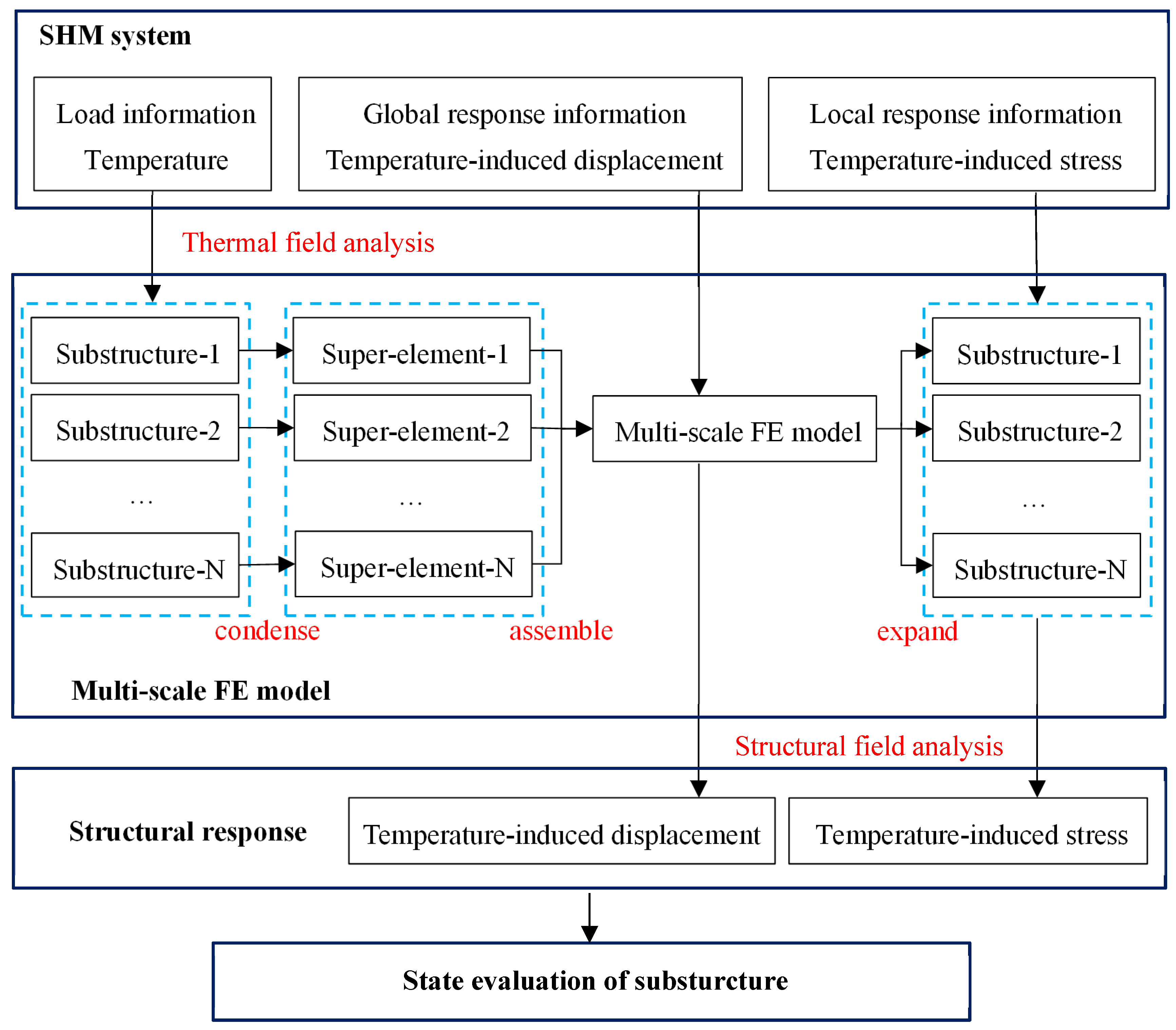






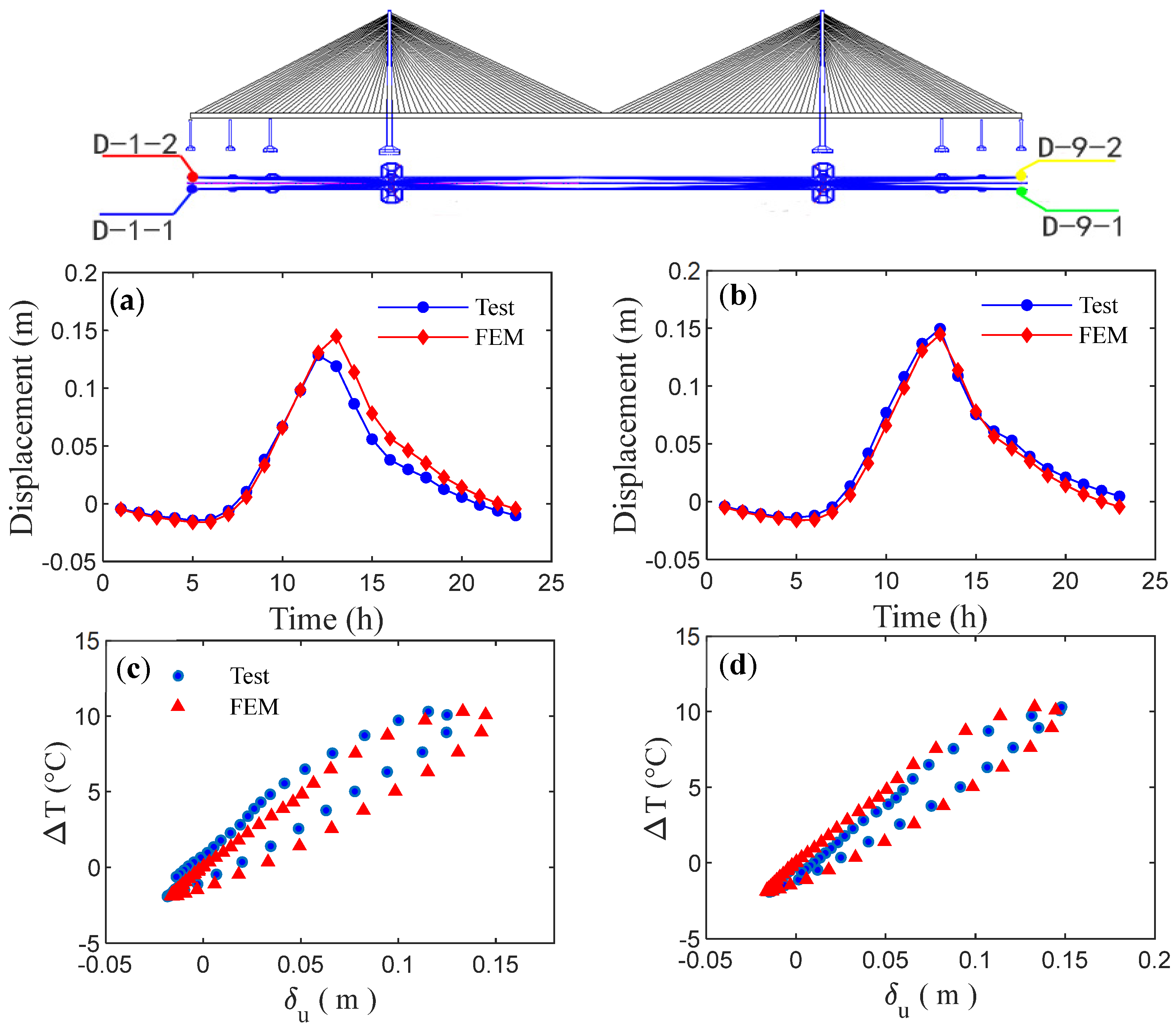


| Top Plate | Top Plate U-Rib | Bottom Plate | Bottom Plate U-Rib |
|---|---|---|---|
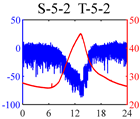 |  | 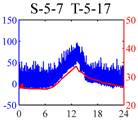 | 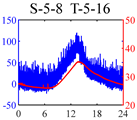 |
 | 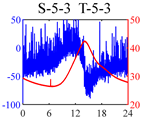 |  | 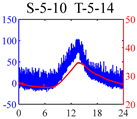 |
 | |||
| Nodes | Elements | DOFs | Thermal Analysis Time (s) | |
|---|---|---|---|---|
| global fine | 1,690,000 | 2,359,862 | 11,274,550 | 625,920 |
| multi-scale | 78,620 | 94,395 | 471,720 | 25,180 |
| Nodes | Elements | DOFs | Static Time (s) | Stress Analysis Time (s) | |
|---|---|---|---|---|---|
| global fine | 1,690,000 | 2,359,862 | 11,274,550 | 26,080 | 625,920 |
| multi-scale | 14,955 | 1035 | 69,272 | 16 | 15,491 |
| Steel | Asphalt | |
|---|---|---|
| thermal conductivity () | 60.5 | 2 |
| heat capacity | 460 | 900 |
| density () | 7850 | 2100 |
Disclaimer/Publisher’s Note: The statements, opinions and data contained in all publications are solely those of the individual author(s) and contributor(s) and not of MDPI and/or the editor(s). MDPI and/or the editor(s) disclaim responsibility for any injury to people or property resulting from any ideas, methods, instructions or products referred to in the content. |
© 2023 by the authors. Licensee MDPI, Basel, Switzerland. This article is an open access article distributed under the terms and conditions of the Creative Commons Attribution (CC BY) license (https://creativecommons.org/licenses/by/4.0/).
Share and Cite
Zhu, F.; Yu, Y.; Li, P.; Zhang, J. The Multi-Scale Model Method for U-Ribs Temperature-Induced Stress Analysis in Long-Span Cable-Stayed Bridges through Monitoring Data. Sustainability 2023, 15, 9149. https://doi.org/10.3390/su15129149
Zhu F, Yu Y, Li P, Zhang J. The Multi-Scale Model Method for U-Ribs Temperature-Induced Stress Analysis in Long-Span Cable-Stayed Bridges through Monitoring Data. Sustainability. 2023; 15(12):9149. https://doi.org/10.3390/su15129149
Chicago/Turabian StyleZhu, Fengqi, Yinquan Yu, Panjie Li, and Jian Zhang. 2023. "The Multi-Scale Model Method for U-Ribs Temperature-Induced Stress Analysis in Long-Span Cable-Stayed Bridges through Monitoring Data" Sustainability 15, no. 12: 9149. https://doi.org/10.3390/su15129149





